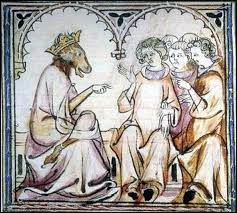
Like the feast of Saturnalia that preceded it, Christmas has a long history of social inversion, of the world turned upside down, of the first being last and the last being first. It begins with the bith of God in a lowly manger and the angelic announcement being made to a group of shepherds. It continued after Christmas had become a state holiday and Byzantine court officials indulged in festive cross-dressing and parody of sacred rites. The Feast of the Ass, the Feast of Fools and the Boy Bishop all had elements of social inversion with the latter designed to reflect the Christian notion that one had to be like a little child to receive the kingdom of Heaven. Inevitably these reversals of the norm were abused leading to irreverence and violence — clergy in Exeter in the fourteenth century, for example, took to throwing mud at each other during Christmas-time services — and they were suppressed by church and governments.
Some echoes of these customs still exist: the Boy Bishop has been revived in some English churches; in Italy children are encouraged to preach at Christmas in front of the Bambino of Ara Coeli; in many armies of the British Commonwealth officers have traditionally served Christmas dinner to the troops. Some have detected social inversion in the Irish hunting of the wren on St. Stephen’s Day — a bird protected all the other days of the year.